COMMENTS ON THE ART MARKET
Gallery News
No More Construction Updates
WE ARE OPEN!
After over eight months of working remotely, we are excited to report that our new and expanded gallery space at 20 West 55th Street is open! The gallery is now divided into two distinct sections. The first is for Rehs Contemporary Galleries, with open ceilings, state-of-the-art lighting, and white walls creating a bright contemporary look. It allows us to display a wider range of works by established and emerging artists, including paintings, sculptures and works on paper.
The more traditional Rehs Galleries section mimics our previous location – dark blue suede walls, dropped ceiling, crown molding, furniture, and carpet. This creates a warm and cozy environment for our collection of 19th and 20th-century works of art.
We are thrilled to be back in person and to have a space that allows us to display our collection in a way that truly does it justice. Whether you're a seasoned art collector or just starting out, we invite you to come and experience our new gallery space. You'll find it an exciting and inspiring environment showcasing the best of what the art world has to offer. The gallery's hours are from 10 am – 5 pm, Monday- Friday.
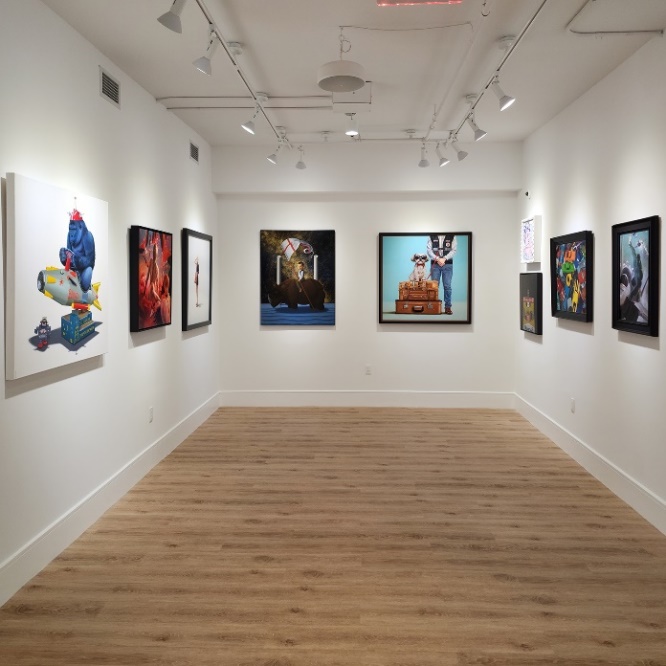
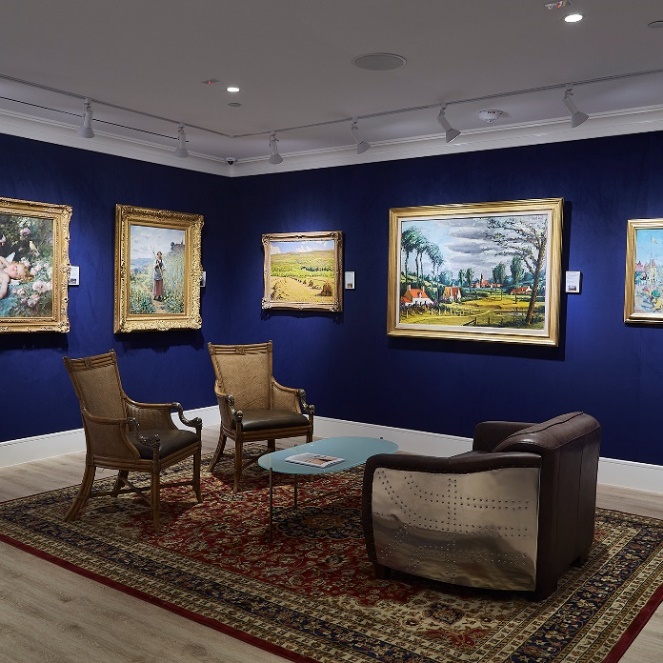
Current Gallery Exhibition
A Solo Exhibition of Works by Josh Tiessen

Josh Tiessen's solo exhibition – Vanitas and Viriditas – is now on view from May 1 through May 26th – Monday through Friday, from 10 am – 5 pm. The exhibition, which can also be seen on our website) features 23 meticulously crafted paintings and drawings, which required more than 5,000 hours of studio work over the course of three years!
Tiessen is an international award-winning artist based in Canada, best known for his hyper-surreal and uniquely shaped oil paintings. His pieces often delve into the interaction between the natural world and humanity, drawing on his studies in philosophy and theology. Continuing on that, Vanitas and Viriditas is an exploration of two divergent perspectives on wisdom and how we might flourish in a modern society filled with facts but mired in confusion.
In The News
Traverse Nature And Humanity Through The Spiritual, Scholarly, Humorous Visual Narratives Of Artist Josh Tiessen - A review of our current exhibition Vanitas + Viriditas by Natasha Gural for Forbes.com.
____________________
Stocks & Crypto
By: Lance
I certainly would not have been the one to guess that the stock market would rally to close out April, and that's probably why people don't pay for my financial advice. While all the major indexes logged gains, something still doesn't feel quite right… I'm looking at you, First Republic. Frankly, going into 2023, the bar was set pretty low… the Fed was already jacking up interest rates, and everyone was talking about a recession – it wouldn't be unimaginable for companies to beat Wall Street's expectations, but that doesn't mean we're in the clear.
By the end of April, the Dow had jumped 2.5%, the NASDAQ was up a mere 0.5%, and the S&P landed between the two with a 1.6% gain; those figures were starkly different last week as it seemed all three would finish the month in the red. Much of the volatility we're seeing is being masked by big-tech stocks that are outperforming the rest of the market – when a select few stocks buoy an index, it gives the appearance that the market is stronger than it actually is… we can see that manifesting in strange ways, like Apple and Microsoft accounting for 14% of the S&P 500 value (the highest in history), or the fact that just 10 stocks are responsible for 90% of the S&P's return this year! This lopsidedness is a major red flag.
Looking at currencies and commodities… the Pound strengthened against the dollar by more than 2%, while the Euro was up by 1.6%. Gold experienced a bit of a pop in the middle of the month, at one point up more than 3.5%, but finished things off with just a 1% gain. Crude was the odd man out, sliding more than 4.5%.
Crypto seems to be maintaining its resurgence… Bitcoin broke $30K for the first time in almost a year, though it now sits at $29.1K – up 2.8% for April. Ethereum gained more than 6% and crossed over the $2K threshold since last May. Litecoin is nearly even with a .06% loss, though it is maintaining a level in the $90-100 range, which is where we were about a year ago.
This coming week could provide some clarity for the near future… nothing is certain, but it seems more likely that the Fed will bump rates again. Although we've had 9 consecutive months of falling inflation, it is still above the target. Further, it was announced in early April that consumer prices rose by 5% year-over-year, far more than the goal of 2%. With that, I'd expect the volatility to drag on into the summer months as the economy continues to flirt with a recession.
____________________
Really!
By: Amy
Vanity License Plate Sets Record
 Did you hear about the guy who just spent Dh55 million ($15 million to you and me) on a license plate in Dubai? I mean, talk about a vanity license plate!
Did you hear about the guy who just spent Dh55 million ($15 million to you and me) on a license plate in Dubai? I mean, talk about a vanity license plate!
The license plate was offered during a charity auction at the Four Seasons Hotel in Jumeirah; the sale was titled "Most Noble Numbers." This plate was simple, P7; apparently, a very low number on your license plate is considered a status symbol in Dubai.
Bidding started at just $4M and quickly drove up to $15M, breaking the previous record of $14.3M set in 2008 when billionaire businessman Saeed Abdul Ghafour Khour bought a single-digit plate at an auction that the same company organized.
Proceeds from the auction, which raised close to $27M in total, will go to the 1 Billion Meals Endowment campaign, a global food initiative founded by Sheikh Mohammed bin Rashid Al Maktoum, emir of Dubai and Prime Minister of the United Arab Emirates, of which Dubai is the largest city.
While the new owner's name has not been released yet, I hope he drives a car that's at least worth a million dollars; otherwise, that license plate will look really out of place on a beat-up old Chevy. Do you think he was trying to impress his friends or maybe just the Sheikh, who knows? Maybe next time they hold the charity auction, a plate with a smiley face or a heart will be up for grabs. I know this all sounds silly for a license plate, but at least the money went to a good cause, right?
____________________
The Dark Side
By: Nathan & Amy
Stolen Antiquities Seized From The Met
Over the past month, my news feed has been bombarded with stories coming out of the Metropolitan Museum of Art in New York. Specifically, these stories are mainly about how investigators have found more and more antiquities in their collections that were originally looted or stolen.
 A third-century headless bronze statue valued at $25 million has been in the Met's collection for over a decade. Some speculate it was originally a statue of the Roman emperor Septimius Severus. Specialists now claim that the statue was stolen from an archaeological site in Bubon in southwestern Turkey. Bubon is the site of a Roman shrine that archaeologists say was dedicated to the Roman imperial cult, or the worship of the imperial family. Artifacts were discovered there by farmers in the 1960s, who subsequently sold the pieces rather than report the find to the relevant authorities as required by Turkish law. The Septimius Severus statue is owned by a Swiss collector who loaned it to the Met in 2011.
A third-century headless bronze statue valued at $25 million has been in the Met's collection for over a decade. Some speculate it was originally a statue of the Roman emperor Septimius Severus. Specialists now claim that the statue was stolen from an archaeological site in Bubon in southwestern Turkey. Bubon is the site of a Roman shrine that archaeologists say was dedicated to the Roman imperial cult, or the worship of the imperial family. Artifacts were discovered there by farmers in the 1960s, who subsequently sold the pieces rather than report the find to the relevant authorities as required by Turkish law. The Septimius Severus statue is owned by a Swiss collector who loaned it to the Met in 2011.
Over the past three months, the Manhattan District Attorney's office confiscated eighteen items from the Met's collection. The alleged Septimius Severus statue is one of several works that the DA's office is repatriating to Turkey, including another bronze statue valued at $1.25 million showing the face of Septimius Severus's son, the emperor Caracalla. The DA's office is handing over twelve items valued at $33 million to Turkey's consul-general in New York. But these were only the most recent antiquities to catch the authorities' attention. Before authorities seized the Septimius Severus statue, the Met announced its plans to remove fifteen Indian sculptures from its collection. This was mainly because of their suspected connections to the disgraced Manhattan antiquities dealer Subhash Kapoor, who was arrested in 2011 and convicted in India just last year of burglary and illegal export. But while the Met removed these pieces from their collection without the DA having to come in and seize them, the museum administration was prompted to take action after the New York Supreme Court granted a warrant for their confiscation.
Though the museum administration is taking steps to address the gaps in the provenance of many of the antiquities in its collection, the Met still has some work to do. A recent report by the International Consortium of Investigative Journalists found that the Met's collection contains "at least 1,109 pieces previously owned by people who had been either indicted or convicted of antiquities crimes." This is mainly because the Met's director between 1967 and 1977, Thomas Hoving, spearheaded a controversial approach that involved spending millions to acquire treasures from around the globe, paying little attention to where and how the previous owners came into their possession. So even though the Met has made some progress, it still has a long way to go. Despite its close relationship with the Manhattan DA's office, the fact that the district attorney had to seize the Roman artifacts instead of the Met independently working to repatriate the pieces to Turkey might show that the museum might be dragging its feet a little in this matter. The Metropolitan Museum of Art is one of the most famous, most visited cultural institutions in the United States and the world, and much of the art world looks to the Met as an example to follow. But yet again, this research takes time. Even today, specialists have difficulty filling gaps in the provenance of certain pieces from decades or even centuries ago.
Roy Lichtenstein: Pioneer Or Plagiarist?
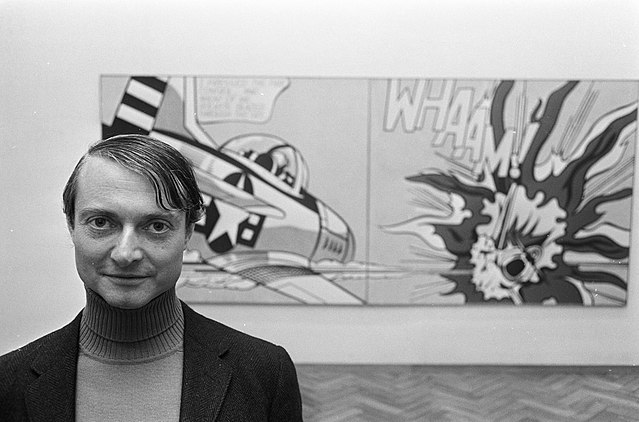 Roy Lichtenstein became one of the most prominent names in American pop art in the 1960s, entering the broader cultural consciousness through his paintings resembling comic strips from pulp magazines and noir serials. Today works like Whaam! and Masterpiece are some of the most recognizable examples of the pop art genre and twentieth-century art in general. But even decades after their creation, Lichtenstein's works are not without their critics, especially when it comes to one of the most pervasive criticisms of pop art: copyright and plagiarism.
Roy Lichtenstein became one of the most prominent names in American pop art in the 1960s, entering the broader cultural consciousness through his paintings resembling comic strips from pulp magazines and noir serials. Today works like Whaam! and Masterpiece are some of the most recognizable examples of the pop art genre and twentieth-century art in general. But even decades after their creation, Lichtenstein's works are not without their critics, especially when it comes to one of the most pervasive criticisms of pop art: copyright and plagiarism.
Last October, the Supreme Court heard oral arguments in a case where a photographer and the Warhol Foundation are suing each other, with the photographer alleging that Andy Warhol had created his portraits of the singer and musician Prince based on one of her photographs. A new documentary entitled WHAM! BLAM! now looks into accusations of plagiarism from comic artists and illustrators who levy several accusations at Lichtenstein for borrowing, stealing, copying, or otherwise heavily drawing upon their work. About thirty comic artists tell their stories about only being paid a few dollars for each illustration they made, only for Lichtenstein to use their work and earn his fame and wealth. Many of the illustrators interviewed claim they were unaware that Lichtenstein had used their work until the producer James Hussey contacted them. Hussey and others attached to the new documentary have repeatedly made it clear that their goal was not to attack Lichtenstein but rather to "stimulate debate" within the art and legal communities about this matter.
Lichtenstein rarely copied and pasted another artist's work outright, making changes while maintaining the original idea behind the illustration. But regardless, Hussey found close to three hundred Lichtenstein paintings that bore more than a passing resemblance to the comic book art of the period he created them. Comic book collector David Barsalous has documented hundreds of these instances through the Deconstructing Roy Lichtenstein project, which he has operated since 2000. Through Barsalou's project, researchers can now see which comic and commercial illustrators whose work Lichtenstein most often borrowed from. These include Ted Galindo, a Marvel illustrator who created the original work seen in Roy Lichtenstein's most valuable painting, Masterpiece, which Agnes Gund sold through New York's Acquavella Gallery for $165 million. There's also John Romita, a Marvel illustrator credited with co-creating the characters of Wolverine, the Punisher, and Mary Jane Watson. Finally, there's Tony Abruzzo, who mainly created romance comics from the 1950s to the 1970s, providing Lichtenstein with the source material for many paintings, including Drowning Girl, In the Car, and Hopeless.
However, Bradford Collins, an art history professor at the University of South Carolina and author of a book on pop art, argues that what Lichtenstein did was not stealing or plagiarism but rather appropriation. Collins says, "With plagiarism, you're stealing somebody's work and using it for the same purpose they did. If Lichtenstein made comic books out of it, that would be stealing. But appropriation means you're taking something and reusing it for a very different purpose, taking something out of a comic book and making it into a painting." At this point, it might seem like Lichtenstein's remaining defenders are splitting hairs and relying mainly on pedantic arguments. But unfortunately, the changes Lichtenstein made and the new context in which he placed his works would be considered "transformative" in many legal settings, meaning technically, the work cannot be officially labeled as plagiarism.
Though Roy Lichtenstein passed away in 1997, his namesake foundation manages his estate, curates his catalogue raisonné, and protects his name, image, and works. The Roy Lichtenstein Foundation even submitted an amicus curiae brief on behalf of the Andy Warhol Foundation in the ongoing case against photographer Lynn Goldsmith. So even though Lichtenstein is not personally profiting from his works anymore, the foundation still licenses the use of his works' images. Meanwhile, the original cartoonists and comic artists whose work Lichtenstein appropriated are in their 80s and 90s, with some needing to rely on charitable organizations for their food, like in the case of illustrator Russ Heath. While some argue that Lichtenstein's work helped elevate the art of comic books, others argue the opposite. Maus creator Art Spiegelman claims, "Lichtenstein did no more or less for comics than Andy Warhol did for soup". But who knows? The upcoming Supreme Court decision involving the Andy Warhol Foundation may open doors for the still-surviving comic book artists whose work Lichtenstein appropriated to receive the credit and financial compensation… or those doors may be closed and locked shut, depending on how things go.
The FBI's New Art App
 In popular culture, many in the United States and beyond think of federal law enforcement agencies like the Federal Bureau of Investigation (FBI) as shadowy organizations watching everything we do. In the eyes of many, they often catch criminals before they can even carry out their nefarious deeds. So, the FBI isn't exactly the kind of organization you think would rely on crowdsourcing. But that's exactly what the FBI is starting to do regarding their National Stolen Art File (NSAF).
In popular culture, many in the United States and beyond think of federal law enforcement agencies like the Federal Bureau of Investigation (FBI) as shadowy organizations watching everything we do. In the eyes of many, they often catch criminals before they can even carry out their nefarious deeds. So, the FBI isn't exactly the kind of organization you think would rely on crowdsourcing. But that's exactly what the FBI is starting to do regarding their National Stolen Art File (NSAF).
While the NSAF has been accessible online for years, this is the first time the FBI has made its database publicly available through a mobile phone application. The FBI released the new app this past Monday, which you can download from any regular app store. It enables anyone with a cellular connection to access the FBI's database of stolen works of art, consisting of thousands of entries, including some submitted as recently as April 8th. Also, the app has a section where anyone can submit a tip to the bureau's Art Crime Team. Even though the app is primarily for law enforcement, and gallery and auction house research specialists, in theory, anyone with the app can search the database to see if an item with gaps in its provenance could be on the list. And it's not just paintings and sculptures. The database also documents stolen books, antique firearms, jewelry, and ceramics.
Of course, the FBI is not the first to release this kind of app. The Italian Carabinieri were the first to release a publicly-available smartphone app in 2014, while Interpol released theirs in 2021. Furthermore, government officials created the FBI app, not software developers. So the database app has a few kinks to work out. Still, making it available to the general public might be an important step in facilitating the identification and return of stolen art.
The Orlando Basquiats: A Year In The Making
 Last year, the FBI raided the Orlando Museum of Art (OMA), confiscating 25 alleged forgeries of works by Jean-Michel Basquiat. Since then, the OMA's board of trustees has fired its chairwoman Cynthia Brumback and the museum director Aaron de Groft, among others. Furthermore, leaked emails show that De Groft was involved in paying $60,000 to a Basquiat expert, Jordana Moore Saggese, in exchange for her attributing one of the paintings in question to Basquiat in her book. Originally, when rumors about the paintings' authenticity went circulating, opinion among experts was pretty divided as to whether said rumors had much substance. But now, these rumors have pretty much been verified after the latest developments coming out of California.
Last year, the FBI raided the Orlando Museum of Art (OMA), confiscating 25 alleged forgeries of works by Jean-Michel Basquiat. Since then, the OMA's board of trustees has fired its chairwoman Cynthia Brumback and the museum director Aaron de Groft, among others. Furthermore, leaked emails show that De Groft was involved in paying $60,000 to a Basquiat expert, Jordana Moore Saggese, in exchange for her attributing one of the paintings in question to Basquiat in her book. Originally, when rumors about the paintings' authenticity went circulating, opinion among experts was pretty divided as to whether said rumors had much substance. But now, these rumors have pretty much been verified after the latest developments coming out of California.
E. Martin Estrada, the US Attorney for the Central District of California, had his office charge a Los Angeles-area auctioneer Michael Barzman with making false statements to the FBI concerning the fake Basquiat case. Barzman originally denied having anything to do with the forged paintings when he first spoke with the FBI last year. However, the jig was up for Barzman when the FBI confronted him with evidence that he had been one of the people who created the works in the first place. The cardboard used as the support for one of the paintings was from a FedEx box with Barzman's name on the mailing label. The FedEx box was the first incongruence viewers noticed, since the box contained a company logo that FedEx would not introduce until 1994, six years after Basquiat's death. Barzman admitted to creating over two dozen works along with an unnamed accomplice. His plea agreement filed with the court says that he and his partner spent no more than half an hour on each painting, which might be incredibly embarrassing to all the Basquiat experts these forgeries fooled.
Barzman worked as an auctioneer specializing in selling off the contents of abandoned storage units in the Los Angeles area. He and his accomplice decided to fabricate a provenance for the paintings, passing them off as the contents of television screenwriter Thad Mumford's abandoned unit. According to Barzman, he told the eventual buyers that Mumford originally purchased the paintings from Basquiat in 1982 for $5,000. While the painting style, the signature, and the provenance fooled many experts, it seems no one at OMA ever bothered to confer with Mumford or the FBI about the matter. The FBI's Art Crime Team has been investigating these forgeries since they first appeared in 2012 and had asked Mumford about them in 2014. The screenwriter said that he had never purchased any work by Jean Michel Basquiat, and even if he did, he did not keep them in his storage unit.
The Orlando Museum of Art has formed a task force intending to help rehabilitate the museum's image in the eyes of both the public and donors. A statement says that the museum "has recommitted itself to its mission to provide excellence in the visual arts with its exhibitions, collections, and educational programming."
The Laziest Fakes: Goya & Velazquez Forgeries Seized In Spain
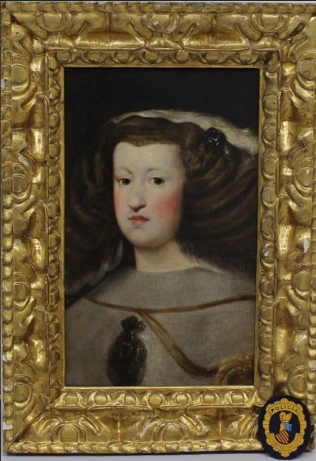 In Spain, the Historic Heritage division of Valencia's regional police seized five paintings said to be forgeries being passed off as originals by the Spanish masters Diego Velázquez and Francisco de Goya. The suspects involved attempted to sell the works for €76 million (or $84 million). The paintings came to the attention of investigators after the owners approached several prospective buyers in the cities of Valencia and Castellón. While a story like this often includes loads of forensic content, with scientists analyzing pigment samples, brushstroke patterns, and provenance documents, none of that was necessary. In what might be one of the laziest examples of art forgery I've ever heard, whoever created these paintings simply copied well-known portraits currently hanging in major museums today.
In Spain, the Historic Heritage division of Valencia's regional police seized five paintings said to be forgeries being passed off as originals by the Spanish masters Diego Velázquez and Francisco de Goya. The suspects involved attempted to sell the works for €76 million (or $84 million). The paintings came to the attention of investigators after the owners approached several prospective buyers in the cities of Valencia and Castellón. While a story like this often includes loads of forensic content, with scientists analyzing pigment samples, brushstroke patterns, and provenance documents, none of that was necessary. In what might be one of the laziest examples of art forgery I've ever heard, whoever created these paintings simply copied well-known portraits currently hanging in major museums today.
Art forgery is one of the lucrative criminal undertakings in Spain, often named in the same breath as the drug trade, weapons trafficking, and prostitution. I've previously written about confiscated forgeries and counterfeit rings broken up by Spanish authorities. Spain is a country that places an immense amount of pride in its national heritage and dedicates large amounts of government resources to trying to protect it. This fact, therefore, makes these forgeries all the more baffling. Even without doing too much work, a casual viewer might recognize one of the forgeries as a portrait of Mariana of Austria, wife of King Philip IV, which now hangs at the Palace of Versailles. The fake is a bust-length cropped version of the original that cuts out her dress's distinctive pannier hoop skirt. Velázquez executed the original work around 1660 when the queen was 26-years-old. Though the 1660 portrait is not as iconic as Velázquez's full-length 1653 portrait that now hangs at the Prado Museum, the queen's stoic expression, rosy cheeks, and wide, braided hairstyle are equally as distinctive as the queen's dress. The suspects were asking for €50 million just for the Mariana portrait.
The scammers passed off the other four works as originals by Francisco de Goya, who initially established himself as a painter for the court of King Charles IV. Portraits of Charles IV and his wife María Luisa of Parma were among the seized paintings. There were just a few problems with them, though. Like the Mariana portrait, these two are nothing but cropped, bust-length copies of the original, full-length paintings, both of which hang in the Prado. More importantly, however, is that the original paintings are not by Goya at all. Rather, they are by the German artist Anton Raphael Mengs, which he created in 1765, the year of the couple's marriage. Each copy was offered at €7 million. The remaining two fake Goya paintings are a pair of religious scenes. The Blessing of Santa Rosa de Lima, with an asking price of €8 million, is less in Goya's style and more characteristic of Italian painters active in the century before Goya's birth. Then, specialists doubt that a trained artist created Allegory of the Pillar of Zaragoza.
These seized forgeries will be displayed at the Valencia Museum of the Enlightenment and Modernity as part of an ongoing exhibition about confiscated counterfeit artworks. Spanish authorities are still in the middle of investigations and have not made any arrests yet. Valencian police will likely charge the four suspects with fraud concerning the paintings and their falsified provenance documents.
Pitfalls Exposed In The Met's Indigenous Art Collection
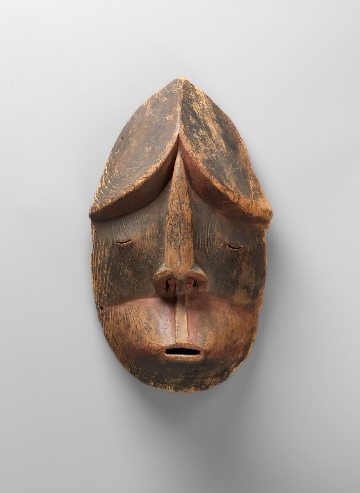 New York's Metropolitan Museum of Art has not had a good year. The Manhattan District Attorney's office and third-party investigators have found that many works in their antiquities collection were previously stolen or looted from their places of origin. I wrote about this when a New York judge granted Manhattan DA a warrant to seize several ancient Roman artifacts looted from an archaeological site in Turkey in the 1960s. Furthermore, authorities found that several other artifacts had connections to the disgraced antiquities dealer Subhash Kapoor. And now, to compound upon the museum administration's woes, ProPublica released a report on Tuesday, April 25th, concerning the troubling facts about the Met's collection of indigenous American art.
New York's Metropolitan Museum of Art has not had a good year. The Manhattan District Attorney's office and third-party investigators have found that many works in their antiquities collection were previously stolen or looted from their places of origin. I wrote about this when a New York judge granted Manhattan DA a warrant to seize several ancient Roman artifacts looted from an archaeological site in Turkey in the 1960s. Furthermore, authorities found that several other artifacts had connections to the disgraced antiquities dealer Subhash Kapoor. And now, to compound upon the museum administration's woes, ProPublica released a report on Tuesday, April 25th, concerning the troubling facts about the Met's collection of indigenous American art.
Some of the more notable pieces in the Met's Indigenous American art collection come from Charles and Valerie Diker. The Art of Native America exhibit is ongoing at the Met, the entire contents of which came from the Dikers' collection. The Met relegates indigenous American, African, and Asian art to their own section of the museum that visitors often stumble into after passing through the Greco-Roman sculpture courtyard. However, the Art of Native America exhibition is situated in the more frequently-visited American Wing of the museum. ProPublica began researching the provenance of the Diker collection after Alaskan native Shyanne Beatty visited the Met in 2018. There, Beatty saw a pair of wooden masks made by Alaska's Alutiiq people that had been stolen in the 1870s. However, the official provenance provided by the Met only starts in 2003, when the Dikers purchased them in California. Beatty was intimately familiar with these masks, as they had been one of the subjects of a documentary she worked on.
The Metropolitan Museum of Art owns one hundred thirty-nine indigenous American artworks that were once part of Charles and Valerie Diker's collection. The couple has been loaning and donating works to the museum since 1993, and in 2017 they generously gifted ninety-one pieces from their collection to the Met. According to the ProPublica report, only 15% of these works have provenances that stand up to scrutiny, and some pieces have no provenance from before the Dikers purchased them. Of course, the Met is not the only American museum with substantial indigenous art collections. However, many of these museums, with less gallery space, fewer donors, and less prestigious reputations, ensure that when it comes to indigenous art, nearly all the pieces in their collections are thoroughly researched and have robust provenances. Some museums will refuse loans or donations if they lack provenance documentation.
Even though legislation has been on the books in the United States for thirty years that should prevent museums from acquiring and keeping stolen or looted indigenous artworks, stories like this still pop into the news cycle again and again. When the Met received the Dikers' gift in 2017, the museum administration, as per the Native American Graves Protection and Repatriation Act of 1990, had six months to reach out to the tribes from which the pieces may have originated. That way, the tribal cultural officials would have the opportunity to notify the museum if a piece had been stolen or looted and educate museum specialists about the artifacts and whether or not it's appropriate to display them in a museum setting. However, the Met often delays doing this. Regarding the Dikers' 2017 gift, the Met did not notify the relevant government agencies until 2022. Additionally, a legal loophole in the 1990 law means that pieces loaned to a museum from a private collection are exempt from these requirements.
Because of the horrible treatment Indigenous American peoples have had to undergo due to official government policy and the actions of independent civilians, information about Indigenous cultural artifacts can be scarce, especially when they've been stolen or looted. The Manhattan District Attorney's office can charge museum officials with criminal possession of stolen property. Still, charges are almost never filed since there's always reasonable doubt about the museum's culpability.
Even though many of these artifacts were stolen or looted decades or centuries ago, people tend to have very long memories when they have been wronged. Therefore, being accommodating to their requests can prove beneficial in several ways. The two Alutiiq masks at the Met were not the only masks that were stolen from Alaska. American and European settlers and explorers looted dozens of caves and burial sites, taking thousands of artifacts. One French looter donated dozens of indigenous artifacts, including many similar masks, to a museum near his home outside of Calais. Nearly a hundred years later, in 2008, the Alutiiq Museum in Kodiak, Alaska, collaborated with this French museum to send thirty-four masks to Alaska as a temporary loan. The exhibit that followed, as a result, had an immense impact. It not only served as a moment of healing for the local population but, according to the museum, local indigenous people are starting to relearn how to create these masks themselves, strengthening their connection to their ancestors and their culture. Repatriation can be a dirty word for some people, but this example shows its positive potential.
____________________
The Art Market
By: Nathan
Bonhams London 19th Century Sale
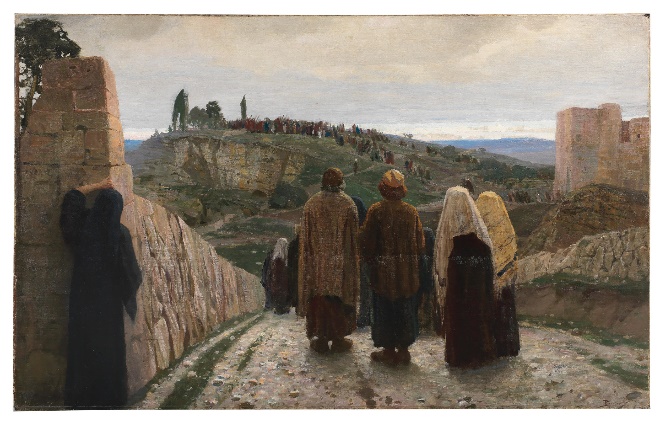 On Wednesday, March 29th, Bonhams New Bond Street location in London hosted its 19th Century and British Impressionist art sale, featuring seventy-three works by both British and Continental European painters (w/p = with buyer's premium). What ended up being the sale's star work was expected to be among the top lots, but Wednesday's bidders brought it right to the top. It was a 1908 oil-on-canvas painting by the Russian artist Vasili Dmitrievich Polenov, with the very long title There were also women looking from afar off. If you're unfamiliar with where the title comes from, you might not know that the work is a biblical scene. All the figures in the foreground have their backs turned to the viewer. The men and women are on the road looking off into the distance at a hill, where a group of people is gathered. The title of the painting comes from the Gospel according to Saint Mark, which describes several of Christ's followers, including Mary Magdalene and Salome, watching from the walls of Jerusalem as soldiers escort Jesus to Calvary, the crucifixion site. The work is part of a series Polenov created called The Life of Christ, consisting of a cycle of twelve paintings. In preparation for the series, Polenov traveled to Egypt, Greece, Syria, and Palestine in the early 1880s, something many of his Orientalist contemporaries did as well, even if their subject matter was entirely different. Bonhams specialists expected the Polenov to bring in £700K at most, yet shot past expectations to reach £1.25M / $1.54M (or £1.54M / $1.9M w/p).
On Wednesday, March 29th, Bonhams New Bond Street location in London hosted its 19th Century and British Impressionist art sale, featuring seventy-three works by both British and Continental European painters (w/p = with buyer's premium). What ended up being the sale's star work was expected to be among the top lots, but Wednesday's bidders brought it right to the top. It was a 1908 oil-on-canvas painting by the Russian artist Vasili Dmitrievich Polenov, with the very long title There were also women looking from afar off. If you're unfamiliar with where the title comes from, you might not know that the work is a biblical scene. All the figures in the foreground have their backs turned to the viewer. The men and women are on the road looking off into the distance at a hill, where a group of people is gathered. The title of the painting comes from the Gospel according to Saint Mark, which describes several of Christ's followers, including Mary Magdalene and Salome, watching from the walls of Jerusalem as soldiers escort Jesus to Calvary, the crucifixion site. The work is part of a series Polenov created called The Life of Christ, consisting of a cycle of twelve paintings. In preparation for the series, Polenov traveled to Egypt, Greece, Syria, and Palestine in the early 1880s, something many of his Orientalist contemporaries did as well, even if their subject matter was entirely different. Bonhams specialists expected the Polenov to bring in £700K at most, yet shot past expectations to reach £1.25M / $1.54M (or £1.54M / $1.9M w/p).
Next was the Frederic, Lord Leighton portrait of a young woman entitled Sea Echoes. The title refers to the subject captured at half-length holding a seashell to her ear. The painting was likely created sometime in the early 1860s, with the same model appearing in several other Leighton works from the same period. Some have theorized that this model was one of Leighton's sisters, Alexandra or Augusta. Sea Echoes is actually one of Leighton's earliest works that evokes sound to determine mood. He would utilize this technique many more times throughout the 1860s, with both natural noise and music. Estimated to sell for between £250K and £350K, Sea Echoes fell nicely within the estimated range at £320K / $394.6K (or £403.5K / $497.5K w/p).
Like Sea Echoes, the third place lot is a nineteenth-century British portrait, this time by one of Leighton's contemporaries, Sir John Everett Millais. Entitled Forget-Me-Not, most specialists have determined the work's subject to be the artist's daughter Effie James. Millais's daughter appears in a costume resembling an almost Victorianized version of dresses found in late eighteenth-century portraiture. The background is made up of muted greens and browns but contains several floral features, indicating that the subject is likely sitting in a garden, where Effie had been picking the forget-me-nots seen in her hand. The Millais portrait sold within its £200K to £300K estimate, with a hammer coming down at £240K / $295.9K (or £302.7K / $373.3K w/p).
In total, twenty-three of the seventy-three lots available sold within the estimate range, giving Bonhams specialists a 32% accuracy rate. Eight lots (11%) sold below estimate, while nineteen lots (26%) sold above. Unfortunately, twenty-three lots (32%) went unsold, and that number is one of the main reasons why the sale did not do well. The entire sale made £2.89M / $3.57M, falling a little short of the £3.15M minimum total estimate. While the number of lots bought-in was troubling, it was actually a single lot that more or less determined the auction's success or failure. The Ionian Dancing Girl by John William Godward shows a Greek girl in a sheer dress with flowers in her hair. Godward is considered one of the great nineteenth-century British classicists. Only Lawrence Alma-Tadema was his rival in capturing the classical world, which in turn has greatly influenced our modern perceptions of the ancient Mediterranean. It's such a pity, therefore, that the bidding stalled at £750K, just shy of Bonhams' £800K minimum estimate where the reserve was likely set. The sale as a whole falling short of its minimum total estimate by about £250K means the auction would have done slightly better had just one more bid come through to sell the painting for £800K.
Christie’s Paris Chagall Et La Musique
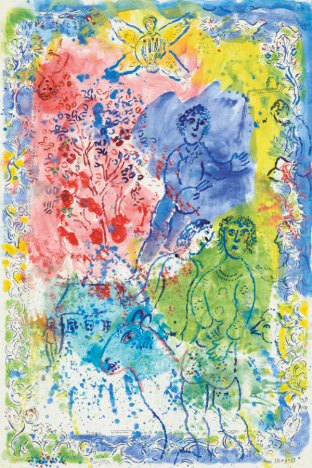 On Tuesday, April 11th, Christie's Paris held an online sale entitled Chagall et la Musique, or Chagall and Music. The works came directly from Marc Chagall's estate, all of which feature musical instruments or were inspired by pieces of music. Music and musical instruments were common themes and subjects in Chagall's work, among the best-known are The Green Violinist and The Bride. With only 50 lots available, Tuesday's sale lasted barely an hour, yet it was incredibly impressive because of the results. It seems Christie's specialists need to get caught up on the market for Chagall works because a majority of the lots sold for more than double their assigned high estimates (w/p = with buyer's premium).
On Tuesday, April 11th, Christie's Paris held an online sale entitled Chagall et la Musique, or Chagall and Music. The works came directly from Marc Chagall's estate, all of which feature musical instruments or were inspired by pieces of music. Music and musical instruments were common themes and subjects in Chagall's work, among the best-known are The Green Violinist and The Bride. With only 50 lots available, Tuesday's sale lasted barely an hour, yet it was incredibly impressive because of the results. It seems Christie's specialists need to get caught up on the market for Chagall works because a majority of the lots sold for more than double their assigned high estimates (w/p = with buyer's premium).
Only a single lot sold within estimate, Rencontre multicolore avec le peintre pour le concert, a work of gouache, tempura, and ink on paper created in 1974. The piece is everything you expect from a work by Marc Chagall, with bright pastel blues, greens, and reds, somewhat floating human figures, and a little bit of Jewish symbolism with a four-winged angel holding a menorah. Christie's specialists estimated Rencontre to sell between €200K and €300K, with the hammer coming down at €280K / $305.57K (or €352.8K / $385K w/p). The lot that came right after it achieved the same hammer price: Violoncelliste rouge et bouc jaune dans un ciel sombre. It is a work of gouache, pastel, and ink on paper created in 1981, and by reaching a €280K hammer price, it exceeded its €180K high estimate by about 56%.
Neither of these works became the top lot of the sale. That designation goes to Orphée, Maquette définitive pour la Mosaïque de la maison John Neff. This is another work on paper, but has an incredibly varied selection of media, including gouache, tempera, ink, pastel, pencil, and a collage of fabrics. Orphée was one of the larger works available on Tuesday, measuring about 29.5 by 54 inches and had an initial high estimate of €250K, which it easily surpassed, selling for €300K / $327.4K (or €378K / $412.5K w/p).
While the top lots were impressive, the most remarkable thing about this sale was that forty-nine of the fifty available lots, or about 98%, sold for over their pre-sale estimates. Thirty-four lots (68%) sold for more than double their high estimates, with seven lots (14%) selling for over five times. The sale's very first lot was the biggest bang: an ink and pencil drawing entitled Ange violoniste pour les programme de concert, created in 1938 and measuring just barely 18 by 11.5 inches. The winged violinist holding a small bouquet was only estimated to sell for between €2K and €3K, but blew all expectations away when online bitters kept the war going and going until it finally sold for €45K / $49.1K (or €56.7K / $61.88K w/p), or about fifteen times the high estimate. The original high pre-sale estimate of €2.29M got blown away, reaching €4.26M / $4.25M, or around 86% higher than what Christie's specialists had predicted.
Sotheby's Paris Impressionniste & Modern
 On Wednesday April 19th, Sotheby's Paris hosted a short impressionist and modern art evening sale. The auction consisted of twenty-one lots that took about an hour to get through, mainly made up of late nineteenth- and early twentieth-century paintings and drawings, along with some sculptures in bronze by Rodin. In first place, one of the three premium lots as determined by Sotheby's, was the Portrait of Jeanne Samary by Pierre Auguste Renoir. Created in 1879 and measuring about 16.25 by 12.5 inches, the painting has spent most of its life in the collection of the same aristocratic family line. The portrait's subject, Jeanne Samary, was a prominent French actress who mainly performed at the Comédie-Française. Renoir created many portraits of her between 1877 and 1881, using her as a model in one of his more famous works, Luncheon of the Boating Party (she can be seen in the upper right-hand corner talking with two men). Expected to sell for no more than €1.5M, Renoir's portrait sold for €1.65 million / $1.8 million (or €2M / $2.24M w/p).
On Wednesday April 19th, Sotheby's Paris hosted a short impressionist and modern art evening sale. The auction consisted of twenty-one lots that took about an hour to get through, mainly made up of late nineteenth- and early twentieth-century paintings and drawings, along with some sculptures in bronze by Rodin. In first place, one of the three premium lots as determined by Sotheby's, was the Portrait of Jeanne Samary by Pierre Auguste Renoir. Created in 1879 and measuring about 16.25 by 12.5 inches, the painting has spent most of its life in the collection of the same aristocratic family line. The portrait's subject, Jeanne Samary, was a prominent French actress who mainly performed at the Comédie-Française. Renoir created many portraits of her between 1877 and 1881, using her as a model in one of his more famous works, Luncheon of the Boating Party (she can be seen in the upper right-hand corner talking with two men). Expected to sell for no more than €1.5M, Renoir's portrait sold for €1.65 million / $1.8 million (or €2M / $2.24M w/p).
Behind the Renoir was Verre et Pichet by Pablo Picasso — a still life of a pitcher and a water glass resting on a tabletop. Like some other Picasso works, not only is this painting dated with the year of its creation, but with a specific date; in this case July 24, 1944. Around this time, Picasso was living in German-occupied Paris, with Allied forces closing in on the city. He had just begun a relationship with Françoise Gilot, an art student who would become an accomplished artist in her own right. Sotheby's specialists predicted that Verre et Pichet would sell for no more than €600K. When the hammer finally came down, it was 83% higher than that, with the still life selling for €1.1M / $1.2M (or €1.38M / $1.5M w/p). And finally, the next lot after the still life was another Picasso painting, dated September 15, 1939. Homme au tricot rayé assis is a sort of gray and beige portrait of a seated man in a striped knitted shirt. Before coming into the seller's possession, the work once belonged to Jacqueline Roque, Pablo Picasso's wife between 1961 and his death in 1973. This work, made of gouache on paper, is one of ten portraits of male figures in striped knitted shirts. Picasso created all of them across four days in September 1939, making some with gouache and others with oil paint. Homme au tricot rayé assis sold for €800K / $876.3K (or €1M / $1.1M w/p), falling nicely within its estimate range between €700K and €1M.
Despite a 43% accuracy rate for the specialists, the Paris impressionist and modern evening sale underperformed slightly. All twenty-one lots were predicted to bring in a total of at least €7.68M, but unfortunately, the auction ended up making somewhat less than that, bringing in €6.71M / $7.35M. If there's one thing to blame, it's one lot that went unsold early in the sale. Claude Monet's landscape Vétheuil is another one of the lots designated as premium by Sotheby's. It is a large, light-colored scene, created around 1901 or 1902, showing the eponymous northern French town, which sits on the banks of the Seine about 37 miles northwest of Paris. Vétheuil was predicted to be the sale's top lot, with an assigned estimate range of €2M to €3M. However, interest that day puttered out at €1.7M, failing to reach its reserve.
____________________
Deeper Thoughts
By: Nathan
Reynolds Rescued
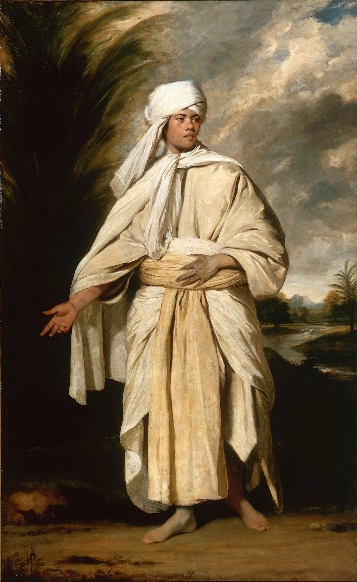 A few weeks ago, I wrote about how one of the most famous works by the British portraitist Sir Joshua Reynolds was in danger of leaving Britain after the government's export bar expired. The National Portrait Gallery in London failed to raise the £50 million necessary to purchase Portrait of Omai to keep it in the country. However, over the weekend, the NPG announced that Omai would be staying in the UK after all, but with one very big condition: it will have to spend some time in the United States.
A few weeks ago, I wrote about how one of the most famous works by the British portraitist Sir Joshua Reynolds was in danger of leaving Britain after the government's export bar expired. The National Portrait Gallery in London failed to raise the £50 million necessary to purchase Portrait of Omai to keep it in the country. However, over the weekend, the NPG announced that Omai would be staying in the UK after all, but with one very big condition: it will have to spend some time in the United States.
While the NPG only raised a little less than half of the funds necessary to buy the portrait, the British government extended their export bar until June 10th, allowing the J. Paul Getty Museum in Los Angeles to come to the rescue and put up the other half. This is the first time a British museum has partnered with an international organization for a single acquisition. While museum collaborations like this aren't exactly new, in Britain, it certainly is a novel idea. It may become a more popular way for cultural institutions to share and display works. The plan is to send the portrait back and forth between the two institutions for six months each. But while some are applauding the NPG and the Getty for their new approach to collaboration, some in Britain are upset that Omai will have to spend half the year in an American museum instead of remaining in Britain year-round. But, of course, many are also recognizing that a compromise like this was very necessary. Due to its large endowment, the Getty Museum is one of the few cultural institutions in the world with extensive funds that would have enabled them to purchase the portrait independently, as they have done in the past with several other export-deferred artworks from Britain. Moreover, I suppose sharing is preferable to losing it altogether for such a significant painting.
But the arrangement is not set in stone yet. The National Portrait Gallery still needs to raise nearly £1 million to make up the difference, which many say should not be that big of an issue. Some, like Christopher Knight of the LA Times, claim this premature announcement is a rare but smart move to get more Brits interested in raising the remaining funds. Should the deal go through, the Portrait of Omai is expected to be displayed at the NPG when it finally reopens on June 22nd after three years of renovations.
Possible Vermeer in Philadelphia
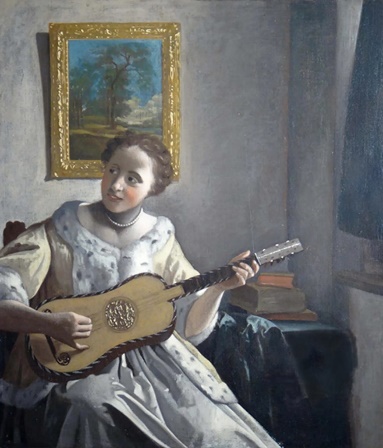
Since 1933, a copy of a painting by Johannes Vermeer known as Lady with a Guitar has sat in storage at the Philadelphia Museum of Art, never having been put on display. For nearly a century, experts believed the work to have been a copy of Vermeer's original painting, The Guitar Player. The original is now owned by Kenwood House, a mansion and museum in central London. However, one specialist is now claiming that it is the Philadelphia work that is, in fact, an original.
Arie Wallert formally worked at the Rijksmuseum in Amsterdam as a scientific specialist. He spoke at a symposium last week at the Rijksmuseum, which currently hosts the largest collection of Vermeer works ever assembled for their current exhibition. There Wallert claimed that the painting in Philadelphia is likely an original work by Johannes Vermeer, created based on the same drawing as the Kenwood version. His claim comes from examining pigment samples taken from the canvas, which show lead-tin yellow, which was only used in Europe until around 1700. The painting also contains ultramarine, an incredibly expensive paint common in Vermeer's work. At the time of the Kenwood version's discovery in 1927, art historians believed it to be an original Vermeer mainly because of its quality. The Philadelphia version is not in the best shape, with much surface damage to the canvas. Other than the condition, the only other difference between the two is the subject's hair. In the Kenwood version, the woman's hair is partially drawn back, with some lively curls coming down the sides of her head. Meanwhile, the subject's hair is completely tied back in the Philadelphia version.
PMA director Sasha Suda responded by not coming down on either side of the issue but hoping this would "inspire discussion" about the work. With this new hypothesis, it is unclear if the PMA will attempt to restore the painting or consider putting it on display in the galleries. But for a city whose teams lost both the Super Bowl and the World Series in the same year, it might be good to give them something nice.
Bernini At The Airport
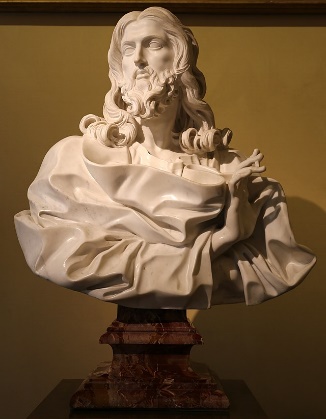 Fiumicino is a small town located about 45 minutes west of the center of Rome. To Romans, Fiumicino means one of two things: the beach or the airport. The Leonardo da Vinci Airport in Fiumicino is where nearly 30 million people per year arrive when flying into Rome. Though it's named after one of Italy's greatest artists and located less than 20 miles from the Colosseum, Italy just has to show off even more of its beautiful culture as soon as you land in the capital. Earlier this week, at Fiumicino Airport's terminal 1, Italy's Interior Ministry put on display the work of another one of its great artists, the baroque sculptor Gian Lorenzo Bernini.
Fiumicino is a small town located about 45 minutes west of the center of Rome. To Romans, Fiumicino means one of two things: the beach or the airport. The Leonardo da Vinci Airport in Fiumicino is where nearly 30 million people per year arrive when flying into Rome. Though it's named after one of Italy's greatest artists and located less than 20 miles from the Colosseum, Italy just has to show off even more of its beautiful culture as soon as you land in the capital. Earlier this week, at Fiumicino Airport's terminal 1, Italy's Interior Ministry put on display the work of another one of its great artists, the baroque sculptor Gian Lorenzo Bernini.
Bernini created Salvator Mundi in 1679, and today it is considered his last great work completed before his death a year later. It is a marble bust of Christ with his right hand extended in benediction. Bernini is intimately connected to Rome, and his work is visible throughout the capital. Whether you are an art historian or just a fan of the book Angels & Demons by Dan Brown, you'll know that the city is dotted with Bernini's sculptures, whether it's inside churches, outside in the piazzas, or within the museums like the Galleria Borghese. And now, to promote Italian arts and culture, the bust is sitting in a glass display case across the terminal from the Eataly outlet.
Bernini died of a stroke in 1680, leaving Salvator Mundi to his friend and patron Christina, Queen of Sweden, who had been living in exile in Rome for the past twenty-five years. After her own death, Christina passed the bust on to the pope, Innocent XI, who would outlive her only by four months. After that, Salvator Mundi stayed with the Odescalchi family, of which Innocent XI was a member. Then, in 1773, the sculpture disappeared. Only a few written descriptions and a single drawing of the work remained. In the 1970s, American art historian Irving Lavin hypothesized that a sculpture in the collection of the Chrysler Museum in Norfolk, Virginia matched Salvator Mundi's description and, therefore, might be the original work or the one recorded copy. After learning that Sées Cathedral in Normandy owns another version of Salvator Mundi, Lavin and some of his colleagues were convinced that the Chrysler Museum version was the original Bernini while the Sées version was the copy. It was only in 2001 that people finally realized that the original version of Salvator Mundi had never left Rome at all.
That year, an exhibition in Urbino dedicated to Pope Clement XI included a photograph of a marble bust of Christ in its catalog. According to the researchers, the bust sits at the pope's family's chapel at the Church of San Sebastiano fuori le mura in Rome. This catalog gets into the hands of Francesco Petrucci, an Italian architect appointed custodian of the Palazzo Chigi, one of Rome's palaces and the prime minister's residence. Petrucci had been involved in Lavin's debates on the Chrysler and Sées version of Bernini's Salvator Mundi, so he was familiar with how the sculpture was supposed to look. Seeing that the exhibition researchers had attributed the work to another sculptor of inferior skill, Petrucci headed to San Sebastiano to see the work for himself. That's when he realized this was, in fact, the work of Gian Lorenzo Bernini himself. Experts now theorize that the sculpture was likely removed from the Odescalchi Palace and moved to the church during the Napoleonic Wars. The year after its rediscovery, art historian Maurizio Fagiolo dell'Arco wrote that while the debate on its authenticity remained open at the time, the fact that Christ's hand appears nearly identical to the hand of Bernini's statue of Constantine in the Vatican is just one point of evidence in the San Sebastiano version's favor. The hand on the Chrysler version seems flat and lifeless by comparison. Even Irving Lavin conceded that the Chrysler version is just, in fact, another copy.
Removing Salvator Mundi from its normal environment and placing it in a display case in the middle of an airport terminal may be a little inappropriate, perhaps. Of course, the goal of promoting Italian arts and culture to incoming visitors is understandable, but was this the right way to go about it? Most tourists visiting the country are there explicitly to experience Italian art and culture. So, I'm not sure they'll need any more prompting by making sure you see a Baroque masterpiece the moment you step off the plane. But regardless, even if you have a layover at Fiumicino, you can tell everyone that the airport had a little more than a duty-free store and a Hudson Booksellers.
Turner: The Father Of Modern Art
 Joseph Mallord William Turner is probably one of the most beloved of Britain's artists. He created works of art which are now recognizable symbols of the British artistic tradition, as well as pioneered techniques that would become the basis of great modern art for the next two hundred years. He was both lauded and lambasted in his lifetime, but he is now often named, along with Joshua Reynolds, John Everett Millais, Thomas Gainsborough, and John Constable, as one of Britain's greatest painters. Today, April 23rd, is his 248th birthday.
Joseph Mallord William Turner is probably one of the most beloved of Britain's artists. He created works of art which are now recognizable symbols of the British artistic tradition, as well as pioneered techniques that would become the basis of great modern art for the next two hundred years. He was both lauded and lambasted in his lifetime, but he is now often named, along with Joshua Reynolds, John Everett Millais, Thomas Gainsborough, and John Constable, as one of Britain's greatest painters. Today, April 23rd, is his 248th birthday.
Turner was considered strange by many of his contemporaries. He was awkward and short-tempered, but most noticeably, he was not very expressive. When he did speak, he did nothing to conceal his modest, working-class London roots. He spoke with a cockney accent that some who attended his lectures at the Royal Academy considered nearly incomprehensible. But despite what some may have gathered from his appearance, demeanor, and background, for much of his career, Turner was one of the most accomplished painters of his day.
Throughout his life, Turner captured a wide variety of subjects on his canvases. In his travels across Britain and continental Europe, he filled countless sketchbooks with thousands of studies for later paintings showing ancient ruins in Rome, Swiss Alpine peaks, and packet boats moored at Dutch ports. His life spanned a turning point in the arts where Western painters were moving away from the historical and mythological subjects preferred by Rubens, Titian, and Jacques Louis David, and more towards elevating the genre of landscape painting. Sir Joshua Reynolds, president of the Royal Academy of Art when Turner entered at age 14, was known for ranking the different styles of painting in a hierarchy of quality. Despite being known primarily today as a portraitist, Reynolds listed portraiture towards the bottom of this hierarchy, along with landscapes and still lifes. It was historical paintings and genre paintings, showing scenes from history, literature, and mythology as well as depictions of everyday life, that were considered the greatest styles of the late eighteenth century. This was mainly because painters like Reynolds believed that art serves as inspiration; by offering images of Greek heroes or the virtuous yeoman of the English countryside, art should provide people with something to aspire to. Landscapes and still lifes, on the other hand, were considered simple representations of the natural world that have little complexity or deeper meaning.
 But by the end of his life, Turner had elevated landscape painting to such heights that he was given the nickname the Painter of Light. His artistic career coincided with the dawning of the Romantic era, which, at least in Britain, emphasized what Edmund Burke called 'the sublime'. The sublime refers to power and greatness, not just in the physical sense but also in the spiritual, the intellectual, and the artistic. In trying to channel the sublime, artists like Turner always strove to capture the power of the natural world, placing human beings in their proper context where nature's monumentality dwarfs our simple goings-on. Turner did so by looking at ships on stormy seas, or clouds and fog banks rolling down a mountainside toward a hunting camp. Even when his subjects were not purely landscapes, Turner always placed nature front and center. When he did eventually dabble in creating great historical paintings, like his 1812 Hannibal and his Army Crossing the Alps, the Carthaginian soldiers and their elephants seem stunted in comparison to the oncoming snowstorm dominating the canvas. In his works created as a commentary on the horrors of slavery, like his 1840 painting The Slave Ship, the tumult of the sea and the brilliant, fiery hues of the sun are some of the most immediately-recognizable features of the work. However, they do not overshadow or distract from the hands of enslaved people bound in chains reaching out of the water as the ship that once carried them sails away.
But by the end of his life, Turner had elevated landscape painting to such heights that he was given the nickname the Painter of Light. His artistic career coincided with the dawning of the Romantic era, which, at least in Britain, emphasized what Edmund Burke called 'the sublime'. The sublime refers to power and greatness, not just in the physical sense but also in the spiritual, the intellectual, and the artistic. In trying to channel the sublime, artists like Turner always strove to capture the power of the natural world, placing human beings in their proper context where nature's monumentality dwarfs our simple goings-on. Turner did so by looking at ships on stormy seas, or clouds and fog banks rolling down a mountainside toward a hunting camp. Even when his subjects were not purely landscapes, Turner always placed nature front and center. When he did eventually dabble in creating great historical paintings, like his 1812 Hannibal and his Army Crossing the Alps, the Carthaginian soldiers and their elephants seem stunted in comparison to the oncoming snowstorm dominating the canvas. In his works created as a commentary on the horrors of slavery, like his 1840 painting The Slave Ship, the tumult of the sea and the brilliant, fiery hues of the sun are some of the most immediately-recognizable features of the work. However, they do not overshadow or distract from the hands of enslaved people bound in chains reaching out of the water as the ship that once carried them sails away.
Though you might not realize it by looking at his maritime scenes or Venetian cityscapes, J.M.W. Turner was far more influential than any of his contemporaries ever expected. He was constantly experimenting with new styles and approaches to painting. He was one of the first to combine the techniques of watercolor with the medium of oil paints, giving his works a light, almost ghostly or ethereal quality never seen before. Some of his paintings from his later life in the 1840s, such as Norham Castle, Sunrise and Rain, Steam and Speed – The Great Western Railway, were highly controversial because of the blurry quality Turner imparted to capture certain kinds of light and, in the case of the latter, to convey a sense of speed. His critics and even his patrons were incredibly confused by this new style that lacked the detail of his early work. Though contemporary critics scoffed at his works from his later life, generations of British and French artists held him in the highest regard, carefully studying his works and techniques. Specifically, French painters like Claude Monet and Camille Pissarro fled to London in 1870 to escape the Franco-Prussian War, where they both came into contact with Turner's paintings. Before then, both were only producing conventional, realist, academic cityscapes, landscapes, and still lifes. Two years after first viewing Turner's works, Monet created Impression, soleil levant. When exhibited in 1874, it gave its name to the new style of modernist art that would later become Impressionism.
Upon his death in 1851, Turner bequeathed all the art remaining in his possession to the British nation, including around three hundred oil paintings. Today the Tate Britain boasts the greatest collection of Turner paintings in the world, with other impressive collections kept at London's National Gallery, other museums across Britain, and several cultural institutions in the United States. A 2005 poll ranked Turner's The Fighting Temeraire as Britain's greatest painting, and it was selected fifteen years later to appear on the £20 note. Turner is often placed at the tail end of the Old Masters, but many refer to him as a sort of proto-Impressionist or even a forerunner of twentieth-century abstract art. Though he was considered rough-around-the-edges by some, and his more experimental art received disdain from his critics, Turner's legacy is undeniable, and his work deserves every bit of praise and adoration it receives both in Britain and beyond.
The Rehs Family
© Rehs Galleries, Inc., New York – May 2023
